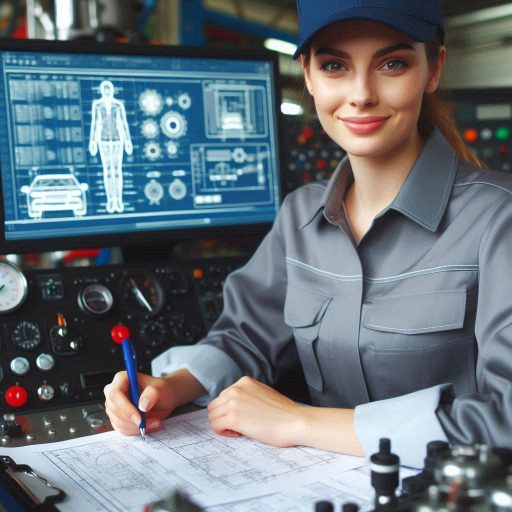Introduction
Automotive engineering is a field dedicated to the design, development, and testing of vehicles and their systems.
It encompasses a range of activities from creating new vehicle designs to improving existing technologies.
Automotive engineers work on everything from engine performance to safety systems, ensuring that vehicles are both functional and reliable.
In recent years, the impact of AI and robotics has significantly transformed the automotive industry.
AI technology enhances vehicle performance through advanced algorithms and machine learning.
It enables features such as adaptive cruise control, predictive maintenance, and sophisticated driver assistance systems.
These innovations make vehicles smarter and more responsive to their environment.
Robotics, on the other hand, has revolutionized the manufacturing process.
Automated systems handle repetitive tasks with high precision, improving efficiency and consistency on production lines.
Robotics reduces human error and accelerates the production cycle, leading to faster and more cost-effective vehicle manufacturing.
The role of AI and robotics in automotive engineering is rapidly expanding.
AI contributes to the development of autonomous vehicles, where machine learning algorithms process vast amounts of data to make real-time driving decisions.
Robotics is also crucial in the assembly of complex vehicle components, ensuring that parts are assembled with precision and speed.
The Evolution of Automotive Engineering
Traditional Methods of Automotive Engineering
Historically, automotive engineering relied heavily on manual labor and mechanical processes.
Engineers used basic tools and machinery to design, test, and manufacture vehicles.
Traditional methods involved extensive manual calculations and physical prototypes.
Design modifications required laborious changes to physical models and components.
Testing often took place on physical tracks or in specialized facilities.
These methods were time-consuming and required significant manual oversight.
The reliance on human skill and physical testing limited the speed and scope of automotive innovation.
How AI and Robotics Have Transformed the Field
AI and robotics have drastically transformed automotive engineering.
AI algorithms now assist in designing and optimizing vehicle systems, speeding up the development process.
Robotics streamline manufacturing processes, increasing precision and reducing human error.
Machine learning models analyze vast amounts of data, improving vehicle performance and safety.
AI-driven simulations replace physical prototypes, allowing engineers to test and refine designs digitally.
Robotics automate repetitive tasks in assembly lines, enhancing production efficiency.
These advancements enable faster innovation and more reliable results.
Examples of AI and Robotics in Automotive Engineering
Several examples illustrate how AI and robotics are reshaping automotive engineering.
Autonomous Vehicles
AI powers self-driving cars by processing data from sensors, cameras, and radar.
Algorithms make real-time driving decisions, allowing vehicles to navigate without human intervention.
Companies like Tesla and Waymo use AI to enhance autonomous driving capabilities, improving safety and convenience.
Predictive Maintenance
AI systems analyze vehicle data to predict when parts need maintenance or replacement.
This proactive approach reduces downtime and prevents costly breakdowns.
For instance, BMW uses AI to monitor vehicle health and predict maintenance needs.
Robotics in Manufacturing
Robotics have revolutionized automotive manufacturing with automated assembly lines.
Robots perform tasks such as welding, painting, and assembling components with high precision.
Ford and Toyota use robotics to streamline production processes, increasing efficiency and consistency.
AI-Enhanced Design
AI assists engineers in designing new vehicles by simulating various conditions and materials.
Generative design algorithms create optimized structures based on performance criteria.
General Motors employs AI-driven design tools to explore innovative solutions and improve vehicle performance.
Advanced Driver-Assistance Systems (ADAS)
AI powers ADAS features like adaptive cruise control, lane-keeping assistance, and automatic emergency braking.
These systems enhance driver safety by providing real-time support and alerts.
Mercedes-Benz integrates AI into its ADAS to offer advanced safety features and improve driving comfort.
The integration of AI and robotics has significantly advanced automotive engineering.
Traditional methods, while foundational, have been enhanced by these technologies.
AI and robotics enable faster development, higher precision, and innovative solutions in vehicle design and manufacturing.
As the industry continues to evolve, these technologies will play an increasingly central role, driving the future of automotive engineering.
Read: Environmental Engineers in the Mining Industry
Benefits of AI and Robotics in Automotive Engineering
Increased Efficiency and Productivity in Manufacturing Processes
AI and robotics streamline automotive manufacturing processes.
Robots handle repetitive tasks with precision and speed.
They perform welding, painting, and assembly with minimal human intervention.
This automation reduces production time and lowers error rates.
AI algorithms optimize manufacturing schedules and resource allocation.
Predictive maintenance powered by AI prevents downtime by identifying issues before they escalate.
As a result, production lines run smoothly, increasing overall efficiency.
Enhanced Safety Features in Vehicles
AI enhances vehicle safety through advanced driver-assistance systems (ADAS).
These systems include features like adaptive cruise control, lane-keeping assist, and automatic emergency braking.
AI algorithms process data from sensors and cameras to make real-time driving decisions.
This technology reduces the likelihood of accidents by alerting drivers to potential hazards.
AI-driven systems also improve crash detection and response.
They analyze impact data to enhance airbag deployment and other safety measures.
As a result, vehicles become safer for both drivers and passengers.
Improved Vehicle Performance and Functionality
Robotics and AI contribute significantly to vehicle performance and functionality.
AI optimizes engine performance by adjusting fuel injection and ignition timing for efficiency.
This leads to better fuel economy and reduced emissions.
Advanced robotics in manufacturing ensures precise assembly of high-performance components.
Vehicles equipped with AI can analyze driving patterns and adjust settings for a customized driving experience.
Additionally, AI-driven diagnostics systems provide real-time insights into vehicle health.
They alert drivers to maintenance needs and potential issues, improving overall reliability.
The synergy of AI and robotics enhances every aspect of automotive engineering.
Robots automate and refine production processes, while AI improves decision-making and functionality.
This integration results in vehicles that are more efficient, safer, and better performing.
Engineers and manufacturers leverage these technologies to stay competitive and meet evolving consumer demands.
The continuous advancement in AI and robotics promises further innovations in the automotive industry.
AI and robotics are transforming automotive engineering by increasing efficiency, enhancing safety, and improving vehicle performance.
Robotics streamline manufacturing processes, while AI adds advanced safety features and optimizes performance.
Together, these technologies push the boundaries of what is possible in automotive design and production.
As the industry evolves, AI and robotics will continue to drive progress, making vehicles smarter, safer, and more efficient.
The future of automotive engineering looks promising, with technology leading the way.
Read: Environmental Engineering and Corporate Social Responsibility
Challenges of implementing AI and robotics in automotive engineering
Cost Implications and the Need for Investment in Technology
The integration of AI and robotics into automotive engineering significantly impacts costs.
Developing advanced technologies requires substantial investment in research and development.
Automakers must allocate funds for cutting-edge equipment, software, and skilled personnel.
Initial costs for implementing AI and robotics can be high, but they promise long-term benefits.
Efficient manufacturing processes and innovative designs often lead to cost savings over time.
Companies investing in these technologies can gain a competitive edge and improve production efficiency.
However, the financial commitment is considerable, and businesses must carefully plan their budgets to accommodate these expenditures.
Strategic investments in technology are essential for staying relevant in the rapidly evolving automotive industry.
Training and Upskilling of Workforce
The rise of AI and robotics in automotive engineering demands a skilled and knowledgeable workforce.
Engineers and technicians must receive specialized training to work with new technologies.
Upskilling programs are crucial for keeping employees abreast of the latest advancements.
Companies need to invest in ongoing education and professional development to maintain a competitive workforce.
Training in AI, machine learning, and robotics equips workers with the skills required for modern automotive engineering tasks.
Upskilling also helps employees adapt to new roles and responsibilities as the technology evolves.
Effective training programs ensure that the workforce can handle complex systems and contribute to technological advancements.
Ethical Concerns Surrounding Autonomous Vehicles
The advent of autonomous vehicles brings significant ethical concerns.
Ensuring safety and making ethical decisions in critical situations are major challenges.
Autonomous systems must be programmed to handle various scenarios, including potential accidents.
Decisions made by AI algorithms can impact human lives, raising questions about accountability and responsibility.
Issues such as privacy, data security, and the potential for job displacement also need to be addressed.
Ethical considerations include how autonomous vehicles should behave in emergency situations and how they affect societal norms.
Ensuring transparency in AI decision-making processes is crucial for gaining public trust.
Addressing these ethical concerns is essential for the responsible development and deployment of autonomous vehicles.
In review, AI and robotics in automotive engineering introduce significant cost implications, requiring careful investment in technology.
Training and upskilling the workforce are essential for adapting to these advancements.
Ethical concerns surrounding autonomous vehicles must be carefully considered to ensure safety and responsibility.
The successful integration of AI and robotics will depend on addressing these challenges effectively and preparing the industry for a technologically advanced future.
Read: The Future of Environmental Engineering Jobs

Learn More: Benefits of Being a Wind Turbine Technician
Transform Your Career Today
Unlock a personalized career strategy that drives real results. Get tailored advice and a roadmap designed just for you.
Start NowCurrent Trends in Automotive Engineering with AI and Robotics
Development of Self-Driving Cars
Self-driving cars, also known as autonomous vehicles, have been a major focus in the automotive industry in recent years.
These vehicles utilize AI algorithms to process data from sensors like cameras, lidar, and radar to navigate roads and make driving decisions without human intervention.
Advancements in AI technology have enabled self-driving cars to interpret road signs, recognize pedestrians and other vehicles, and react to changing road conditions in real-time.
Companies like Tesla, Waymo, and Uber have been at the forefront of developing and testing autonomous vehicles on public roads.
The ultimate goal of self-driving cars is to increase road safety, reduce traffic congestion, and provide greater mobility for individuals who are unable to drive themselves.
While there are still regulatory and ethical challenges to overcome, the development of self-driving cars represents a significant shift in the automotive industry towards AI-driven technologies.
Integration of AI in Vehicle Maintenance and Diagnostics
AI is also being integrated into vehicle maintenance and diagnostics systems to improve efficiency and reduce costs.
AI-powered tools can analyze vehicle data in real-time to predict when maintenance is needed, identify potential issues before they become major problems, and recommend solutions for optimal vehicle performance.
For example, predictive maintenance systems use machine learning algorithms to monitor factors like engine temperature, oil levels, and tire pressure to anticipate when a vehicle may require servicing.
This proactive approach helps to prevent breakdowns and prolong the lifespan of vehicles, saving both time and money for car owners.
AI is also being used in vehicle diagnostics to diagnose mechanical problems more accurately and quickly than traditional methods.
By analyzing data from onboard sensors and diagnostic tools, AI systems can pinpoint the root cause of issues and provide detailed reports for technicians to address the problem efficiently.
Advancements in Connectivity and Communication Systems in Vehicles
The rise of AI and robotics in automotive engineering has also led to significant advancements in connectivity and communication systems within vehicles.
Modern cars are increasingly equipped with smart features like voice assistants, telematics systems, and integrated mobile apps that rely on AI algorithms to provide personalized experiences for drivers and passengers.
AI-powered infotainment systems can learn drivers’ preferences for music, navigation, and climate control, adjusting settings automatically to enhance the driving experience.
These systems also enable seamless integration with smartphones and other devices, allowing users to stay connected while on the road.
Furthermore, connected vehicle technologies enable cars to communicate with each other and with infrastructure systems to improve road safety and traffic flow.
AI algorithms can analyze data from multiple sources, such as traffic cameras and sensors, to predict traffic patterns, suggest optimal routes, and alert drivers to potential hazards, ultimately leading to a more efficient and safer driving environment.
Read: Sustainable Wastewater Treatment Methods
You Might Also Like: Impact of AI on Field Service Technician Jobs
Future Outlook of Automotive Engineering with AI and Robotics
As we look towards the future of automotive engineering, it is clear that AI and robotics will play a significant role in shaping the industry.
Prediction of Fully Autonomous Vehicles on the Road
One of the most anticipated developments in the automotive industry is the widespread adoption of fully autonomous vehicles.
With advancements in AI and robotics, companies like Tesla and Google are making significant strides towards achieving this goal.
The ability of self-driving cars to navigate complex road conditions and make split-second decisions will revolutionize the way we travel.
It is predicted that within the next decade, autonomous vehicles will be a common sight on roads around the world, leading to increased safety and efficiency in transportation.
Possibility of AI Designing Vehicles
Another exciting prospect in automotive engineering is the potential for AI to design vehicles.
Companies are already using AI algorithms to generate innovative vehicle designs that optimize aerodynamics, fuel efficiency, and safety.
This capability allows engineers to explore new design possibilities that were previously unimaginable.
With AI’s ability to process vast amounts of data and simulate different scenarios, the design process can be streamlined and accelerated, leading to faster development cycles and more innovative vehicles.
Potential for AI and Robotics to Revolutionize the Automotive Industry
The integration of AI and robotics in the automotive industry has the potential to revolutionize the way vehicles are manufactured, operated, and maintained.
AI-powered robotics can automate tedious and dangerous tasks in factories, leading to increased productivity and precision in production lines.
Robots equipped with AI algorithms can also assist in vehicle maintenance and repair, reducing downtime and costs for owners.
The combination of AI and robotics will enable car manufacturers to create more customized, efficient, and intelligent vehicles that cater to the evolving needs of consumers.
- Improved Safety: AI-powered systems can analyze real-time data to predict and prevent accidents on the road, making transportation safer for passengers and pedestrians.
- Enhanced Efficiency: Autonomous vehicles can optimize routes, reduce traffic congestion, and minimize fuel consumption, leading to more efficient transportation systems.
- Innovative Design: AI algorithms can generate creative vehicle designs that prioritize performance, sustainability, and user experience, pushing the boundaries of traditional automotive engineering.
- Cost-Effective Manufacturing: Robotics equipped with AI can streamline production processes, reduce waste, and lower manufacturing costs, making vehicles more affordable for consumers.
- Sustainable Solutions: AI can help car manufacturers develop eco-friendly vehicles that reduce emissions and promote environmental sustainability, contributing to a greener future.
Essentially, the future of automotive engineering with AI and robotics looks promising.
As technology continues to advance, we can expect to see fully autonomous vehicles on the road, AI-designed vehicles, and a revolutionized automotive industry that prioritizes safety, efficiency, innovation, and sustainability.
By harnessing the power of AI and robotics, car manufacturers are poised to create a smarter, safer, and more sustainable future for transportation.
Explore Further: Navigating Job Interviews for Drafter Positions
Conclusion
Automotive engineering is rapidly evolving due to advancements in AI and robotics.
These technologies have revolutionized the way vehicles are designed, manufactured, and operated.
AI algorithms are being used to optimize vehicle performance, enhance safety features, and improve overall efficiency.
Robotics, on the other hand, are streamlining production processes and increasing precision in manufacturing.
The significance of AI and robotics in automotive engineering cannot be overstated.
They are paving the way for autonomous vehicles, predictive maintenance, and personalized driving experiences.
As we look towards the future, it is crucial to continue exploring the potential of AI and robotics in automotive engineering.
More research and innovation in this field will lead to groundbreaking developments and advancements that will shape the industry for years to come.
Engineers, researchers, and industry professionals are encouraged to delve deeper into the possibilities offered by AI and robotics in automotive engineering.
By collaborating and pushing the boundaries of technology, we can unlock new opportunities and create a more sustainable and efficient automotive landscape.




